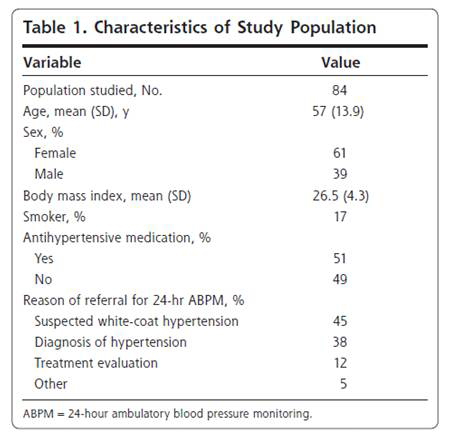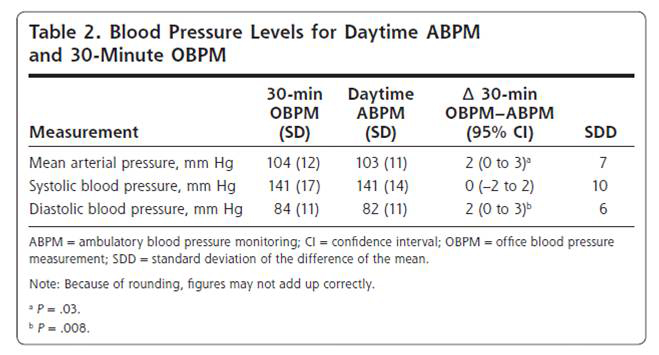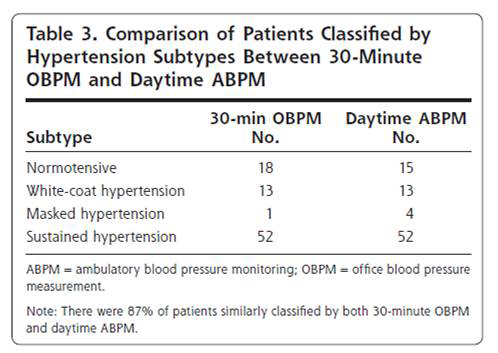【文献名】
Mark C van der Wel et al. : A Novel Approach to Office Blood Pressure Measurement: 30-Minute Office Blood Pressure vs Daytime Ambulatory Blood Pressure Ann Fam Med 2011;9:128-135.
【要約】
<Background>
Current office blood pressure measurement (OBPM) is often not executed according to guidelines and cannot prevent the white-coat effect. Moreover, large number of studies suggest the risk of cardiovascular complication correlates more closely with 24 hour or daytime ABPM than office BP.
<Purpose>
Serial, automated, oscillometric OBPM has the potential to overcome both these problems.
We therefore developed a 30-minute OBPM method that we compared with daytime ambulatory blood pressure.
<Methods>
Patients referred to a primary care diagnostic center for 24-hour ambulatory blood pressure monitoring (ABPM) had their blood pressure measured using the same validated ABPM device for both ABPM and 30-minute OBPMs. Known atrial fibrillation, irregular pulse, pregnancy, and night shift work were exclusion criteria.
All 30-minute measurements took place between 11 AM and 3 PM in a quiet room at the diagnostic center. The patient was sitting still 5 minutes before and during the 30-minute OBPM. The patient sat in a chair with a supported back, arm at heart level, and both feet resting flat on the floor. Blood pressure was measured on the nondominant arm at 5-minute intervals for a total of 8 measurements. The first measurement was a test measurement during the installation of the patient. The second measurement was the start of the 30-minute period; the researcher left the room after this measurement proved to be successful (no error reading).
We define 30-minute OBPM to be the mean blood pressure calculated from the 6 measurements taken at 5-minute intervals from t = 5 to t = 30 minutes. If more than 1 of these 6 measurements was erroneous (defined as an “error” reading given by the device), the entire case was excluded for analysis.
The mean 30-minute OBPM (based on t = 5 to t = 30 minutes) was compared with mean daytime ABPM using paired t tests and the approach described by Bland and Altman on method comparison.
In the absence of usual care office blood pressure measurements, we defined office blood pressure
as the mean of the first 2 measurements of the 30-minute OBPM.
<Results>
We analyzed data from 84 patients (mean age 57 years; 61% female). Patients characteristics are shown in table1 below. Systolic and diastolic blood pressures differed from 0 to 2 mm Hg (95% confidence interval, ?2 to 2 mm Hg and from 0 to 3 mm Hg) between mean 30-minute OBPM and daytime ABPM, respectively. The limits of agreement were between ?19 and 19 mm Hg for systolic and ?10 and 13 mm Hg for diastolic blood pressures.(Table2)
Both 30-minute OBPM and daytime ABPM classified normotension, whitecoat hypertension, masked hypertension, and sustained hypertension equally(Table3).
<Conclusion and discussion>
The 30-minute OBPM appears to agree well with daytime ABPM and has the potential to detect white-coat and masked hypertension. This finding makes 30-minute OBPM a promising new method to determine blood pressure during diagnosis and follow-up of patients with elevated blood pressures.
※A device used in this study.
http://www.ciao.co.uk/Welch_Allyn_Cardioperfect_6100_Series_Ambulatory_Blood_Pressure_Monitor__6861410
【開催日】
2011年6月1日


